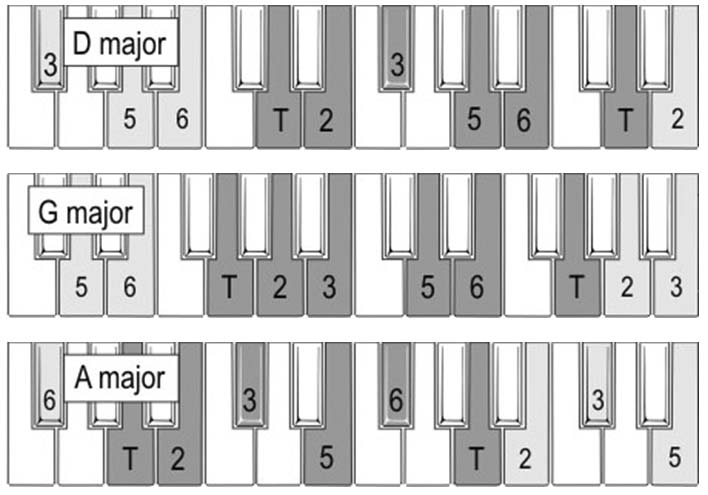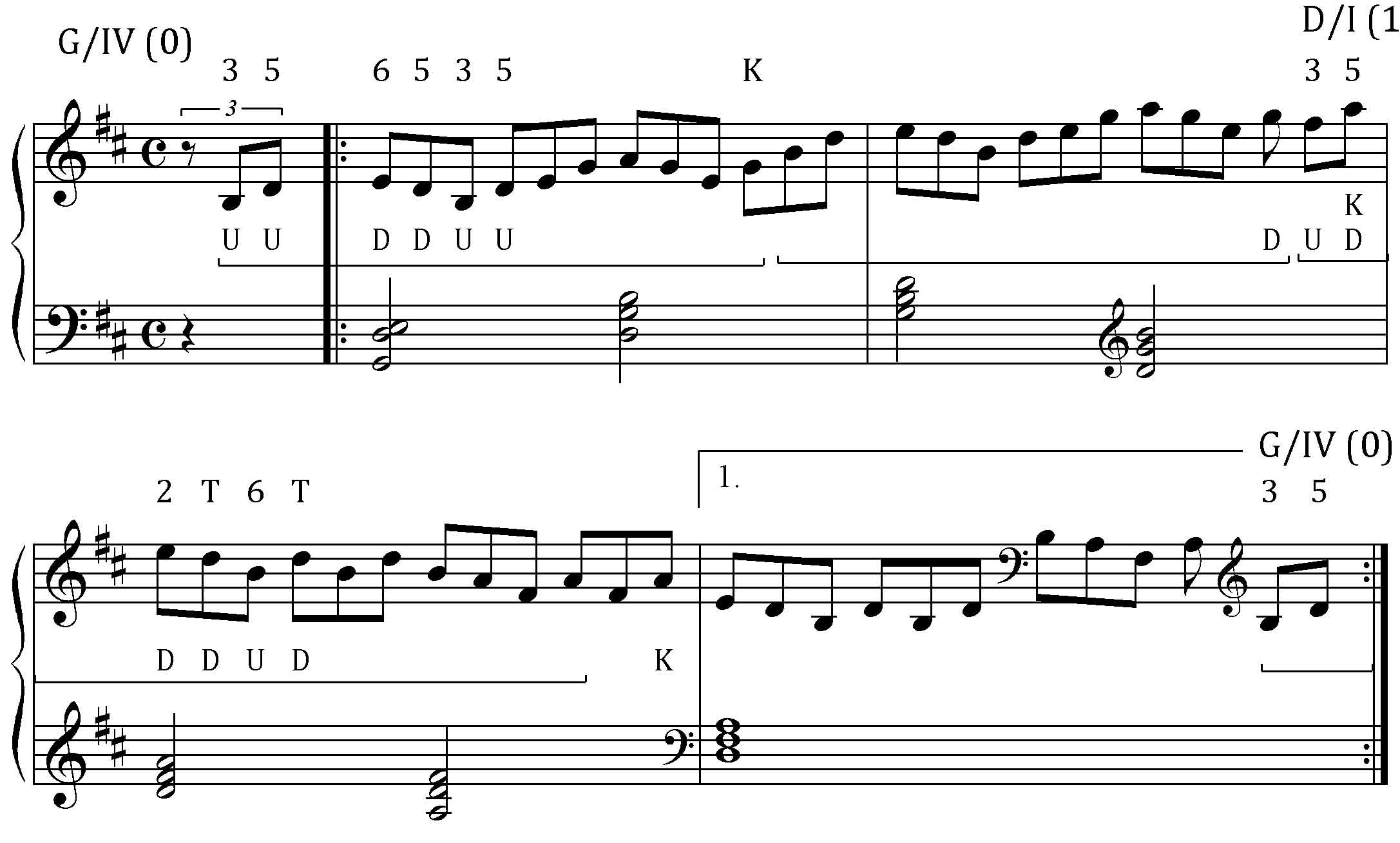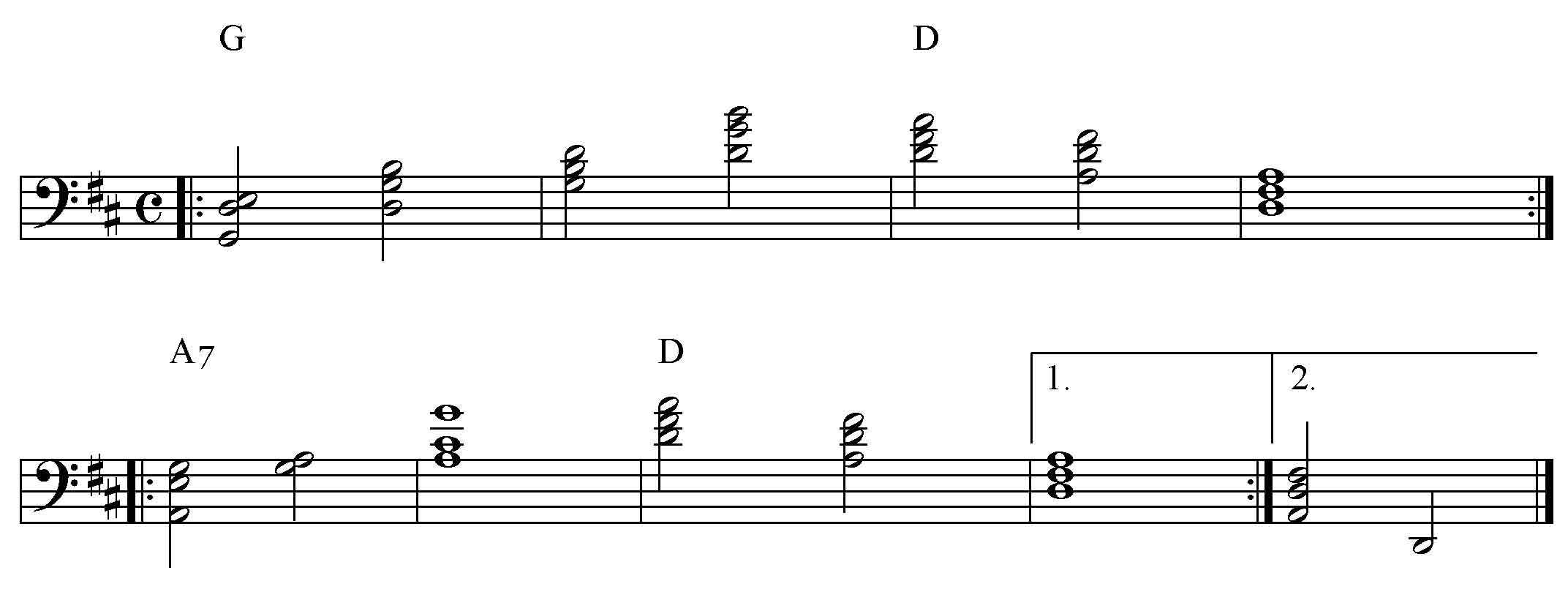Musicarta Pentatonics Workbook
A Melodic Pentatonic Study
Part One - Version in D
This study should convince you that the pentatonic scales are indeed "nearly music already". All the pentatonic scale tones sound good over major triads and even seventh chords (both types – major and dominant) - with just a very few 'avoid these' exceptions.
Watch the first performance. It's in the key of D major, but the first chord is G, and the right hand is playing the G major pentatonic scale. There are two performances.
Chord structure
The study uses the three chords you are most likely to find in any key.
· Tonic - the key name chord, chord I
· Subdominant - chord IV, a fourth above the tonic
· Dominant - chord V, a fifth above the tonic
In the key of D major, these are D, G and A. The left hand will play D, G or A chords (perhaps with some added tones), and the right hand plays patterns in the respective major pentatonic scales.
Here are the three major pentatonic keyboards. The right hand uses only the basic five-tone pentatonic scale with no chromatic passing tones – it is 'diatonic'.
 |
Note: The keyboards do not align vertically. |
Keeping glancing at the diagrams as you work through the module. Pentatonic scales have only whole tone and minor third intervals between the scale-tones.

Counting the A major pentatonic scale
You may not have come across the two-black-key A major pentatonic scale yet. Count it out along with me.
Fingering the patterns
It's no use thinking the fingering is just going to 'sort itself out'. Not dealing with fingering is the main reason so many pieces are abandoned and never make into the performer's repertoire.
It's the varying black-key quotient that presents the challenge:
· D major (chord I): One black key – F sharp
· G major (chord IV): No black keys
· A major (chord V): Two black keys – F and C sharps.
Watch the video and use the drills to practice sensible fingering for the scale-tone patterns in the three keys so you can play the patterns smoothly.
Counting the up-down patterns
Hearing pentatonic scale-tone pattern in your head in terms of up, down, step and skip is a good basis for rock-pop improvisation
Look at the right hand melodic patterns in depth before you start playing.
Don't expect to remember these descriptions by reading them - and you don't have to 'go through the motions' to train your eye and ear to see the patterns. Patterns make making music easy!

You see that from the first melody note, the melody goes up (U), up (U), down (D), down (D), up (U), up (U). That pattern repeats, and that fills the first bracket. All the notes are next-door pentatonic scale-tones – steps. Because they are all steps, we don't have to indicate that – just whether they go up (U) or down (D) to the next note.
Because some of the 'steps' in the pentatonic scale are already minor thirds (three semitones), you have to look and listen hard for these skips, but they make the pattern clear.
The twelve notes then repeat an octave higher (second bracket), but to start the repeat, the melody skips up – misses a pentatonic scale tone, A. This is indicated by the 'K' (for skip) over the G.
So that U-U-D-D-U-U recipe accounts for the whole first line, apart from the G at the end of the second bracket where the new pattern starts.
Second pattern
The melodic patterns in the study have two 'pick-up' notes – two notes before the bar line – the official start. So the second pattern starts before the end of the first line. That's why you see the D chord symbol there.

This pattern is:
U-D-D-D-U-D
More downs than ups - the melody is falling.
The first 'down' in the pattern is a skip – from A over the F sharp to E.
The second group of six notes is U-D-D-D-U-D again (all of the descending D chord melody is), but with no skip. Then the twelve notes repeat an octave lower.
Use the shorthand
The start of the patterns is marked with the pentatonic scale-tone shorthand (T, 2, 3, 5, 6). This shorthand is numbered from the chord, so the first two notes are the third and fifth of chord G, not D major – the key of the piece.
With practice, you should be able to hear the music just looking at those first few letters – after that, the pattern takes over generating the melody.
The left hand chords in D
Practice the left hand chords separately. Some of them aren't ordinary triads, and there's no regular pattern.
The first G chord has an added sixth but no third. The A chords are in fact A7 chords. Some of these also do not have thirds.

No matter how simple a left hand part looks, it doesn't turn out to be so easy when you start playing hands together. Some concentrated, speedy LH-only practice is always good value.
Putting the hands together
Practice hands together two bars at a time, until you can play
- The G major ascending pattern;
- The D descending pattern;
- The A7 ascending pattern;
- The final D descending pattern.
Then 'stitch' the first two together, then the last two, then the two halves.
Be prepared to go through this build-up process a number of times.
Archive videos
Here are a couple of archive videos for this module. They might shed light!
Going on from here
The idea behind the classical keyboard 'study' is to practice a typical (and useful) keyboard texture and/or harmonic material - here, both: essentially, soloing in the pentatonic scales over left hand supporting chords.
Don't be surprised then if you're tempted to branch out and try another scale-tone pattern or just follow you ear into a scale-tone meander. It's free to try!
When you're ready, go on to Page Two of this module and rehearse the material in A. The more times you go over it, the closer it gets to being a permanent improvising/soloing resource.
Building on your achievement
Keep coming back to this study, playing up and down the familiar pentatonic scale-tone patterns in the D and A major study chord sequences, or just freely up and down the D chord, the A chord, and so on.
You might find you are able to hear-and-see the patterns in your mind's eye as or before they play – because of the attractiveness and simplicity of the pentatonic scale.
Repeated practice will also improve your instinctive fingering, arranging for you always to have the fingers there to keep the notes coming.
|
OUT NOW! |
THE MUSICARTA BEAT & RHYTHM WORKBOOK At last! An effective approach to keyboard rhythm & syncopation skills. Learn more! |
ONLY $24.95! |
|
THE MUSICARTA PENTATONICS WORKBOOK video course
Introductory
Practice Patterns
Melody Work and
Playing by Ear
Pentatonic Riffs
and Diaries - Minor Pentatonic Major Pentatonic
Chromatic Minor
Chromatic Major
Pre-video Pages
Pentatonics videos
Archive Pages
|
The MusicartaA methodical approach to keyboard syncopation for
|
PUBLICATIONS
exciting keyboard
creativity courses
CHORDS 101
WORKBOOK

~HANON~
video course

Musicarta
Patreon
PENTATONICS
WORKBOOK
video course

Creative Keyboard
video course

BEAT AND RHYTHM
WORKBOOK

- Volume 1 -

12-BAR PIANO
STYLES WORKBOOK

MUSICARTA MODES
WORKBOOK

PIANO STYLE

CANON PROJECT
video course

VARIATIONS
video course


- Piano Solo -
video course

- Piano Solo -


YouTube playlists





 THE LOGO
THE LOGO
